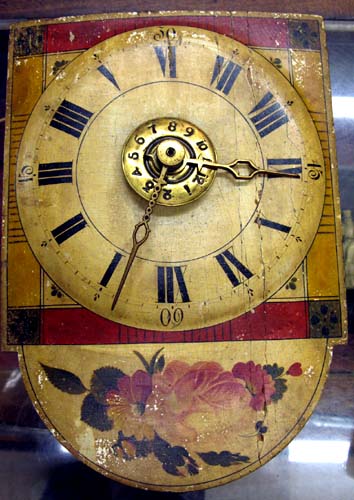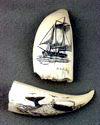Research on Antiques & Collectibles

Research on Antiques & Collectibles |
|
|||
|
|
 WOOD CLOCKS OF 19thC AMERICA In Connecticut, between 1810 and 1812, Seth Thomas and Silas Hoadley produced 8-day wood clocks designed for a long case, and also 8-day wood shelf clocks which are supposed to have appeared soon after 1820. Undoubtedly these long-case clock movements, few of which have been found, represent Connecticut's attempt to enter the 8-day wood clock field. The basic Connecticut wood-clock movement is the cumbersome 30-hour "Cheney movement" which was being made in Hartford County as early as 1745. Although the method of placing the weight cords differed, both movements were "pull-ups,".... Read Full Story
|
|
||||||

MARITIME FOLK ART: Scrimshaws, Walrus Tasks, Sperm Whale Teeth and other marine body parts as Art
The North Pacific and the South Seas were the principal source of scrimshaw for more than a hundred years after 1800. These miniature carvings and engravings on ivory, bone, or wood were made by whalers as an escape from the monotony of a prolonged cruise which might keep the men away from home ports for four or five years. When whales failed to show up and the ship was becalmed, existence in narrow and filthy quarters became an ordeal for crew and officers alike. Nerves were frayed, tempers grew short, and quarrels.... Read Full Story

MARITIME & SHIPS FIGUREHEADS
The age-old feeling that a ship has life was expressed for centuries in the practice of decorating ship's bows with carvings representing living things. Although some ships had gracefully carved fiddle-scroll decorations, called billet heads, mounted on their bows, carvings of animate creatures were much more commonly used for this purpose. Two stories illustrate how vividly, in the minds of the crew, the figurehead took on the personality of its model. In 1800 H.M.S. Royal George whose figurehead was in the likeness of the King, was forced to decline engagement with some French warships; and the bosun, to spare his sovereign the disgraceful sight of a British ship fleeing the enemy, lashed a hammock around the.... Read Full Story